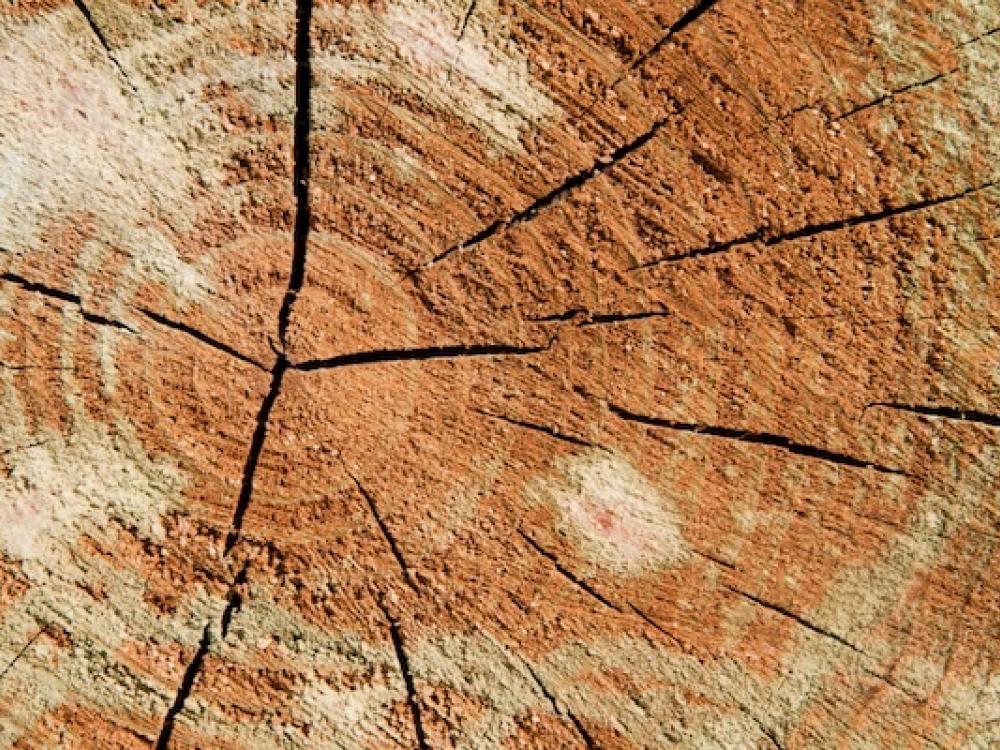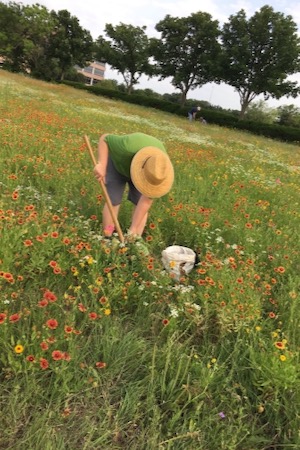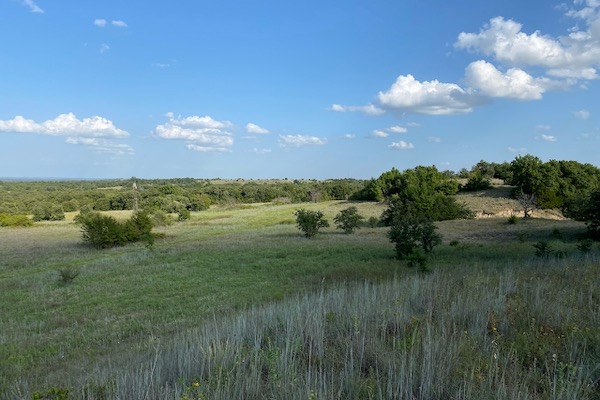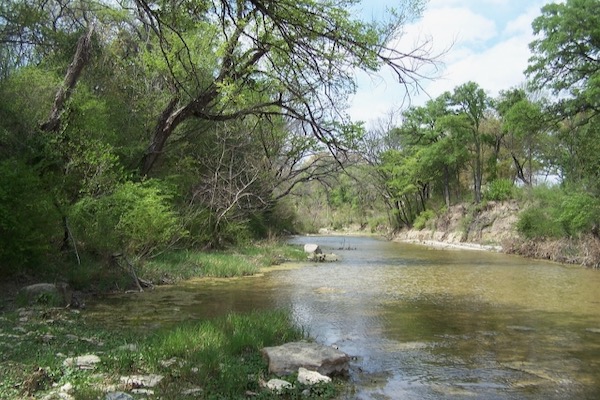
Coping with ecological losses as the built world expands can be challenging for nature lovers. Photo courtesy of Storyblocks.
Feb. 24, 2022
What should we call a place we’ve known for years with intimate familiarity — where we feel secure, happy and cared for? The word “home” comes to mind, but for many people that word is reserved for a structure, a house that we own or pay for.
There is a creek I have visited for nearly 60 years. It gives me happiness and nurtures my spirit but I do not own it. Likewise, I have explored and re-visited the LBJ National Grasslands for over 20 years, and it has come to represent those same experiences of wonder, familiarity and peace.
Places like these become personally meaningful to us, and their importance is a kind of first cousin to “home.” Losing them would be terrible.
A favorite outdoor locale can produce many of the positive feelings we associate with home. Photo by Michael Smith.BIOPHILIA
We can form attachments to nature in a broader sense. Whether it's a clear creek with trees towering over its limestone banks, or a prairie brimming with native grasses and wildflowers, we can care about it even if we’re seeing it for the first time. Even though it's not "my creek" or "my prairie."
As a species we got our start in places like that. And as a culture most of our ancestors “grew up” there in small, rural communities. Within living memory, many kids lived on farms or visited grandparents’ ranches. Some people carry the memory of a particular tree in a particular park, or a landscape that meant the world to them.
There are a number of science-based ideas that seek to explain why these natural places can feel so significant. Biologist Edward O. Wilson borrowed the term “biophilia” to describe an innate tendency for us to seek connections to living things. Other researchers have demonstrated the ways in which time spent in nature can lower stress, alleviate depressive symptoms and recharge our batteries.
No wonder nature is so important to many of us. We have deep connections to it, whether we remember those connections or not.
 THE BUILT WORLD
THE BUILT WORLD
Volunteers rescue wildflowers from a prairie remnant slated to be bulldozed in Fort Worth. Photo by Julie Thibodeaux.
But the arc of most human societies bends toward growth and converting nature into goods. There are ever more of us (about 7.9 billion human souls at this point) and resources such as soil, plants and minerals have declined by about 40 percent since the 1990s.
Whether it is loss of rainforest globally or the sale of prairies around Fort Worth, nature is being lost everywhere.
Not only is nature being bulldozed and converted to the “built world” of highways and big box stores, it is being scorched and flooded by human-caused climate change. And so, the losses accumulate and we pay an enormous price. Some of it is financial, from crop losses and weather catastrophes, and some of it is an emotional and psychological toll. That toll can include what is termed “environmental grief.”
SOLASTALGIA
You are familiar with grief – that difficult process in which we work through the loss of someone or something of great emotional significance. In grief we can experience sadness, emptiness, anger, guilt and other emotions. Hopefully, we reach some sort of acceptance of the loss, even though we may revisit the pain from time to time. Environmental grief has been described in indigenous societies that lose some culturally important place such as a melted glacier or flooded homes.
As parts of the wild creek that I loved were disappearing, what I experienced could be called “solastalgia.” It is a little like nostalgia, when we feel a longing for something we experienced in the past.
With solastalgia, however, we feel distress as places in the environment are lost while we watch and cannot do anything about it. I feel solastalgia as more patches of prairie are cleared at LBJ Grasslands to accommodate more fracking wells.
 LBJ National Grasslands, one of the author's favorite respites. Not pictured are spots that have been cleared for fracking. Photo by Michael Smith.
LBJ National Grasslands, one of the author's favorite respites. Not pictured are spots that have been cleared for fracking. Photo by Michael Smith.
STAGES OF GRIEF
At times I might respond to such losses with denial. After a person dies, family members sometimes say, “I just keep waiting for him to walk through the door,” trying to push the loss away as if it had not happened.
In a related gesture, I frame photographs of wild places, excluding buildings and other aspects of the built world as much as possible.
I caught myself doing that on a recent walk at Tandy Hills Natural Area, a lovely prairie remnant in Fort Worth. In my photographs, you would not know it’s surrounded by a highway and a broadcast tower. My camera becomes a tool of denial.
Our grief might also take a more active form. Arriving at some familiar spot to find the bulldozers at work, a person might well up with tears or become angry.
“They had no business doing that,” or “I’d like to tell off the people who decided to do this.”
Another aspect of grieving is described as “bargaining.”
“I’d give all I own to be able to walk that place one more time,” and similar statements. We wish we could do something to get the lost place or the lost loved one back, even though it is not possible.
These things help protect us from being overwhelmed by loss.
A grieving person is not trying to fool anyone. They just need time to process their loss and to slow that freight train of emotions down. They would otherwise stand unprotected in a terrible storm of grief.
Given time and the support of loved ones, most emerge on the other side where there is some peace and acceptance.
Grieving nature is more complicated, because often it is a slow motion loss. Instead of attending a funeral and going home, we continue to sit at the bedside and watch helplessly as the decline progresses.
ECOLOGICAL GRIEF
Scientists and clinicians are looking at how environmental or ecological grief works and who is most affected. Those especially vulnerable include field biologists and probably anyone who is out in nature regularly and may be more likely to see what is being lost.
Aldo Leopold famously wrote that “One of the penalties of an ecological education is that one lives alone in a world of wounds,” meaning that they see the ecological harm that others do not notice.
Climate change is bringing fires, floods, droughts, sea level rise and a host of other problems to our news reports and increasingly to our direct experience.
If you are worried about how nature is being harmed, you are not a “snowflake,” you are just paying attention.
 Keeping a nature journal can be a way of honoring your love for nature. Photo by Julie Thibodeaux.
Keeping a nature journal can be a way of honoring your love for nature. Photo by Julie Thibodeaux.
TIPS FOR GRIEVING
We do not need to sit with our grief passively. There are important things we can do to, as a clinician would say, “do the work of grief.” Based on my training as a clinician, what others have taught, and my own experience of lost places, here are some ideas:
• Share your feelings with those you trust. Find people who understand that your worry about the future or your feelings of loss are real and meaningful. Talk about how anxiety and/or grief are affecting you.
• Celebrate places where nature thrives. This can be a powerful reminder that while there is loss, there is also survival. There are places where our love of nature and our advocacy succeed. Visiting them or sharing photos or stories can be helpful.
• Advocate for nature. We can speak up for wild places and for protecting the climate, air and water. Mobilizing your energy and feeling like you have a voice combats the helplessness we sometimes feel. And you are needed — our small voices add up to a more powerful voice.
• Practice mindfullness. Find time to be completely open to the present, especially when you are out in nature. Grief and anxiety get us stuck in past memories or worries about tomorrow. With mindfulness, we step outside of that spiral and simply experience the present moment.
• Honor what you love and what you have lost. One way to do that is by drawing or writing about your time in a place. A nature journal is a wonderful way to do this. Other ways to honor nature could be through prayer or meditation.
• Talk with a counselor. If you are stuck in frequent grief and anxiety, especially if the strategies listed above don’t work, contact a therapist or counselor. There is a Climate-Aware Therapist Directory online that lists a few therapists in the DFW area. The directory states:
“Climate-aware therapists are professionally-trained psychotherapists who recognize that the climate crisis is both a global threat to all life on Earth and a deeply personal threat to the mental and physical well-being … of each individual, family and community on the planet.”
I spoke with one of the counselors listed in the directory. Heather Cohen is a licensed professional counselor who sees people for a variety of issues, including anyone for whom environmental grief or eco-anxiety are concerns.
She said that environmental grief and anxiety are not pathologies reflecting some disorder within the person, but rather they are rational and appropriate responses to troubling situations. She emphasized the value of active strategies such as the above, putting a person in a position of doing something about the problems we are facing.
RELATED ARTICLES
‘Mindfulness’ enhances nature walks
Critter-related phobias can keep us from enjoying nature
Goodbye to a prairie: Richardson meadow slated for development
Big trees need more protection, say DFW advocates
Stay up to date on everything green in North Texas, including the latest news and events! Sign up for the weekly Green Source DFW Newsletter! Follow us on Facebook and Twitter. Also check out our new podcast The Texas Green Report, available on your favorite podcast app.










